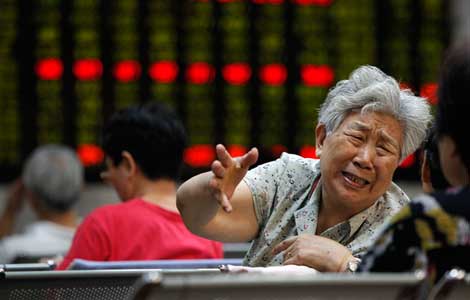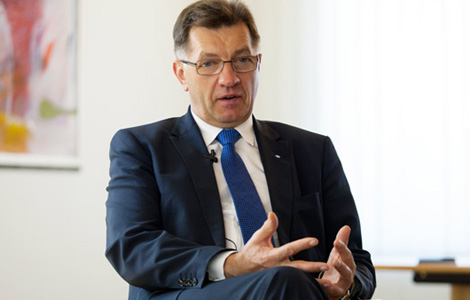Avoid victimizing others
Updated: 2013-07-30 07:19
By Yu Xiang (China Daily)
|
||||||||
US Federal Reserve should take the global economy into consideration when implementing its retreat from QE
Recently the US Federal Reserve stated its intention to draw its quantitative easing policy to an end. Although the Fed's officials, including Ben Bernanke himself, have repeatedly stressed that the final decision on when has not been made, based on the United States' economic situation and the conditions given by Bernanke for quitting quantitative easing, it is highly probable it will take place within the year.
The economic indicators have been favorable for quitting, as inflation fell below 2 percent and the unemployment rate is falling. Since April of last year, the US' annual inflation rate has remained low at between 1.3 and 1.9 percent. Since last December, the unemployment rate has declined to 7.6 percent, and although it has not yet dropped to 7 percent, there are reasons to expect the Fed will not wait for that to happen. As long as the unemployment rate declines steadily for three consecutive months, monetary policy adjustments will occur. Of course, other factors, such as second and third quarter GDP growth, the fiscal situation, market response, and even pressure from US President Barack Obama will influence the Fed's final decision.
More importantly, the Fed has started to release signals to test market response, which means the Fed has figured out a retreat strategy. On Dec 13, Bernanke first mentioned exit conditions. Then on May 22, Bernanke said at a congressional hearing the Fed will consider the scale of its retreat from quantitative easing. And on June 19, the Fed issued a monetary policy statement after the Federal Open Market Committee meeting saying, "The scale of monthly equity purchase may be cut later this year."
The Fed's retreat strategy will be step by step. The first step will be reducing purchase scale, limiting the Fed's balance sheet expansion. Specifically, the first step will be to reduce the current monthly purchase scale from $85 billion to $50-60 billion, and then drop to $30 billion, before finally stopping. Then in the mid-term, the Fed will adjust its balance sheet structure, gradually raising the benchmark interest rate. In the long term, the Fed will sell bonds bought under its quantitative easing policies.
While the Fed has a roadmap for its retreat, any negligence may lead to huge economic risks, which is of big concern to US investors and of even more concern to the investors in emerging economies.
Undeniably, the implementation of quantitative easing has played a big role in propelling the US economy out of the crisis, which has boosted emerging countries' exports to the US. But it is also undeniable that its implementation has undermined the stability of their economic recovery. Many emerging economies, including China, face major challenges from inflation and asset bubbles. In nature, quantitative easing is diluting the US debt by releasing extra liquidity, making other countries share the costs of the US' crisis. Ultimately, emerging markets are the biggest victims of the US' quantitative easing.
But, by retreating from quantitative easing the US will again make emerging economies the victims. The capital outflows have already intensified, as international short-term speculative capital is treating the retreat as a signal that the US economy is going strong, so they are selling out Asian assets on a large scale and putting the money in the US. China's foreign exchange data has mirrored this trend.
The net purchase of foreign exchanges hit a six-month low of 66.86 billion yuan ($11 billion) in May, slumping from 295.35 billion in April and 315.3 billion in average during the first four months of the year, according to data released by the People's Bank of China.
Second, external financial market turmoil has increased. On June 13, out of fear the Fed's FOMC meeting would lead to the decision to quit quantitative easing, emerging markets fell across the board. On June 14, better-than-expected retail sales and employment data boosted emerging countries' markets sharply, but on June 19, after laying out its timetable for quitting quantitative easing, the Morgan Stanley Emerging Markets Index dropped 4 percent and the Hong Kong stock market fell 2.88 percent. Since the beginning of the year, emerging markets have dropped about 20 percent.
Third, emerging economies' monetary policies are trapped. On June 13, Indonesia's central bank unexpectedly announced its intention to raise the benchmark interest rate by 25 basis points to 6 percent. Only two days ago, the Indonesian central bank raised its overnight deposit rate. Brazil is in the same situation as Indonesia. Within several months, Brazil has raised its benchmark interest rate twice. On May 29, Brazil's central bank dramatically raised the benchmark interest rate by 50 basis points, far more than expected. Additionally, because of the scaling down of quantitative easing, the Indian rupee's rapid depreciation was a key reason India's central bank "reluctantly" kept interest rates unchanged and suppressed the urge to cut interest rates again.
Due to their concerns about the US ending its quantitative easing, the International Monetary Fund, the World Bank, the European Union and South Korea recently asked the US to deal with it carefully and responsibly to prevent economic and financial risks. On July 11, at the fifth round of the China-US Strategic and Economic Dialogue, Chinese Finance Minister Lou Jiwei said the US should take full account of the impact on the world economy, which is the first time a high-level Chinese official has publicly talked about this, indicating a real and potentially big impact on China.
China and the US should grasp this opportunity to deepen China-US relations, as preventing any adverse effects from the US' withdrawal from quantitative easing provides a new platform for cooperation. Increasing the transparency of monetary policy, preventing flows of hot money and strengthening financial supervision are tangible tools to enrich a "new pattern of major power relations".
The author is a research fellow at the Institute of American Studies at the China Institutes of Contemporary International Relations (CICIR). www.chinausfocus.com
(China Daily USA 07/30/2013 page11)
Most Viewed
Editor's Picks

|

|

|

|

|

|
Today's Top News
Former US president plans to visit DPRK
China struggles to retain talents
Families of crash victims to sue Asiana in the US
Detroit: Gold mine for China
Major SOEs eye profits from abroad
Train collision kills at least 44 in Switzerland
Sino-Japanese summit ruled out
Manila's base plan targets China
US Weekly

|

|















